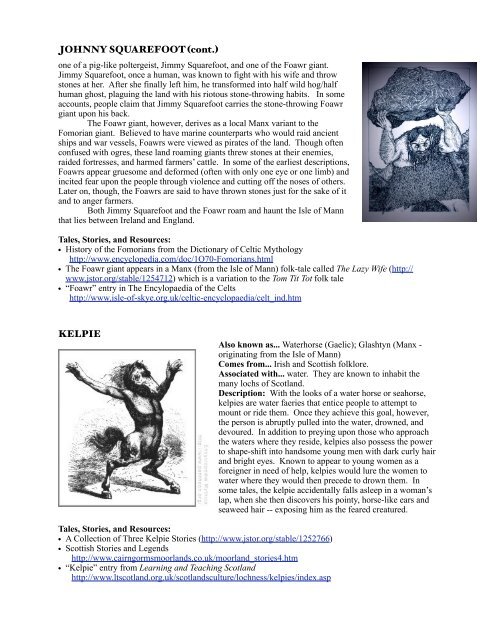The Skriker Actor Packet
The Skriker Actor Packet
The Skriker Actor Packet
Create successful ePaper yourself
Turn your PDF publications into a flip-book with our unique Google optimized e-Paper software.
JOHNNY SQUAREFOOT !cont."<br />
one of a pig-like poltergeist, Jimmy Squarefoot, and one of the Foawr giant.<br />
Jimmy Squarefoot, once a human, was known to fight with his wife and throw<br />
stones at her. After she finally left him, he transformed into half wild hog/half<br />
human ghost, plaguing the land with his riotous stone-throwing habits. In some<br />
accounts, people claim that Jimmy Squarefoot carries the stone-throwing Foawr<br />
giant upon his back.<br />
<strong>The</strong> Foawr giant, however, derives as a local Manx variant to the<br />
Fomorian giant. Believed to have marine counterparts who would raid ancient<br />
ships and war vessels, Foawrs were viewed as pirates of the land. Though often<br />
confused with ogres, these land roaming giants threw stones at their enemies,<br />
raided fortresses, and harmed farmers’ cattle. In some of the earliest descriptions,<br />
Foawrs appear gruesome and deformed (often with only one eye or one limb) and<br />
incited fear upon the people through violence and cutting off the noses of others.<br />
Later on, though, the Foawrs are said to have thrown stones just for the sake of it<br />
and to anger farmers.<br />
Both Jimmy Squarefoot and the Foawr roam and haunt the Isle of Mann<br />
that lies between Ireland and England.<br />
Tales, Stories, and Resources:<br />
• History of the Fomorians from the Dictionary of Celtic Mythology<br />
http://www.encyclopedia.com/doc/1O70-Fomorians.html<br />
• <strong>The</strong> Foawr giant appears in a Manx (from the Isle of Mann) folk-tale called <strong>The</strong> Lazy Wife (http://<br />
www.jstor.org/stable/1254712) which is a variation to the Tom Tit Tot folk tale<br />
• “Foawr” entry in <strong>The</strong> Encylopaedia of the Celts<br />
http://www.isle-of-skye.org.uk/celtic-encyclopaedia/celt_ind.htm<br />
KELPIE<br />
Also known as... Waterhorse (Gaelic); Glashtyn (Manx -<br />
originating from the Isle of Mann)<br />
Comes from... Irish and Scottish folklore.<br />
Associated with... water. <strong>The</strong>y are known to inhabit the<br />
many lochs of Scotland.<br />
Description: With the looks of a water horse or seahorse,<br />
kelpies are water faeries that entice people to attempt to<br />
mount or ride them. Once they achieve this goal, however,<br />
the person is abruptly pulled into the water, drowned, and<br />
devoured. In addition to preying upon those who approach<br />
the waters where they reside, kelpies also possess the power<br />
to shape-shift into handsome young men with dark curly hair<br />
and bright eyes. Known to appear to young women as a<br />
foreigner in need of help, kelpies would lure the women to<br />
water where they would then precede to drown them. In<br />
some tales, the kelpie accidentally falls asleep in a woman’s<br />
lap, when she then discovers his pointy, horse-like ears and<br />
seaweed hair -- exposing him as the feared creatured.<br />
Tales, Stories, and Resources:<br />
• A Collection of Three Kelpie Stories (http://www.jstor.org/stable/1252766)<br />
• Scottish Stories and Legends<br />
http://www.cairngormsmoorlands.co.uk/moorland_stories4.htm<br />
• “Kelpie” entry from Learning and Teaching Scotland<br />
http://www.ltscotland.org.uk/scotlandsculture/lochness/kelpies/index.asp



